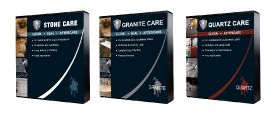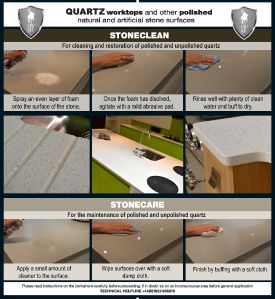
Marble, granite and quartz are all popular choices for counter tops and vanity units. Each material provides a hardwearing surface and there’s an abundance of fabulous finishes to choose from. So, how do you look after these surfaces, in order to maintain performance and that elegant aesthetic?
More about the materials
Although marble, granite and quartz have similarities, they are quite different in their make-up. Marble and granite are both natural stones. Marble is a metamorphic rock that forms when limestone is subjected to the heat and pressure of metamorphism. It is made up of recrystallized carbonate minerals, commonly calcite or dolomite. Granite is a coarse-grained intrusive igneous rock that forms from magma (with a high content of silica and alkali metal oxides) that slowly cools and solidifies underground. It is mostly composed of quartz, alkali feldspar and plagioclase. Quartz worktops are engineered from ground quartz – a hard, crystalline mineral that’s made up of silica – and mixed with resin. Some quartz countertops also include other stone aggregates, like granite and marble.
Different performance features
Marble and granite are both acid sensitive. However, granite is more robust and marble, being more porous, is vulnerable to abrasion. Quartz is generally less sensitive to acid, unless it includes acid sensitive stone. However, it has a low resistance to thermal shock, due to its resin content, so it can scorch easier. Care should be taken to use heat resistant mats, coasters or trivets to protect the surface.
To look after each material, we recommend our worktop care kits: LTP Stone Care Kit, Granite Care Kit and Quartz Care Kit.

Which surfaces need to be sealed?
Marble and granite should always be sealed to protect them from stains, whereas Quartz doesn’t generally need to be sealed. Our Stone Care Kit and Granite Care Kit include three treatments - to deep clean, seal and maintain - and our Quartz Care Kit includes two, to deep clean and maintain.
The deep cleaning treatment should always be used to remove residue before sealing marble or granite. If dirt and residue is left in place, it will become sandwiched between the stone and the sealer, creating a patchy finish.
Deep cleaning
How to apply LTP Stone Clean/Granite Clean/Quartz Clean
Shake the can. To apply the foam treatment, just point and spray in a sweeping action, 15-20cm from the surface. Leave for 5-10 minutes and then agitate the surface with a white emulsifying pad and a little water. Rinse with a clean sponge and clean water. Repeat the treatment if the stone is very stained.
Sealing
How to apply Stone Seal/Granite Seal
As above, shake the can and point & spray in a sweeping action, 15-20cm from the surface. A little water can be dropped onto the surface 30 minutes after application, to test the protection. If it’s absorbed, a second or third coat can be applied to give maximum protection. The surface will be fully dry within 2-3 hours of the final application, and fully cured after three days. On smooth, polished surfaces, any visible excess should be removed five minutes after application, with an absorbent cloth. The surface should be buffed with a soft lint-free cloth. Always ensure that rooms are well ventilated before applying the treatments.


Ongoing care
All three surfaces – marble, granite and quartz - should be maintained with a gentle, pH-neutral cleaner. General surface cleaners should be avoided, as they are often quite acidic; even many of the eco brands aren’t recommended for acid sensitive stone. This is also the case for quartz, as whilst it is generally more resistant, strong chemicals can still cause staining and dull a polished surface.
How to apply LTP Stone Care/Granite Care/Quartz Care
Shake the can, hold 15-20 cm from the surface and spray a small amount. Wipe over with a damp cloth. Rub until dry using a dry micro-fibre cloth or similar absorbent towel to finish.
During each stage of treatment, rooms should be well ventilated. For more advice on all of the kits and individual treatments, visit https://www.ltp-online.co.uk/cat/worktop-care. To contact LTP for more expert advice, tel. 01823 666213 or email [email protected]



